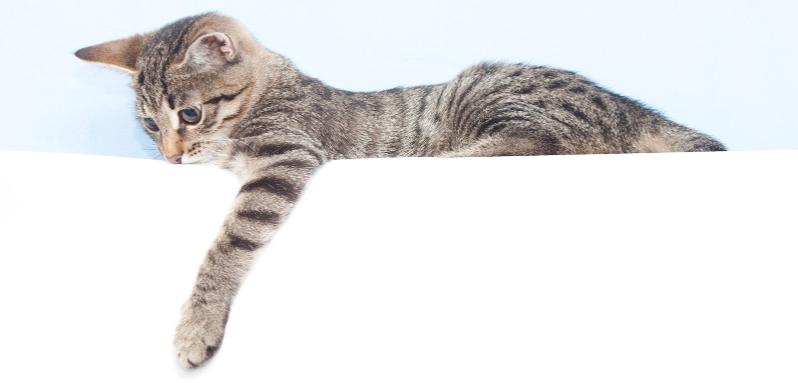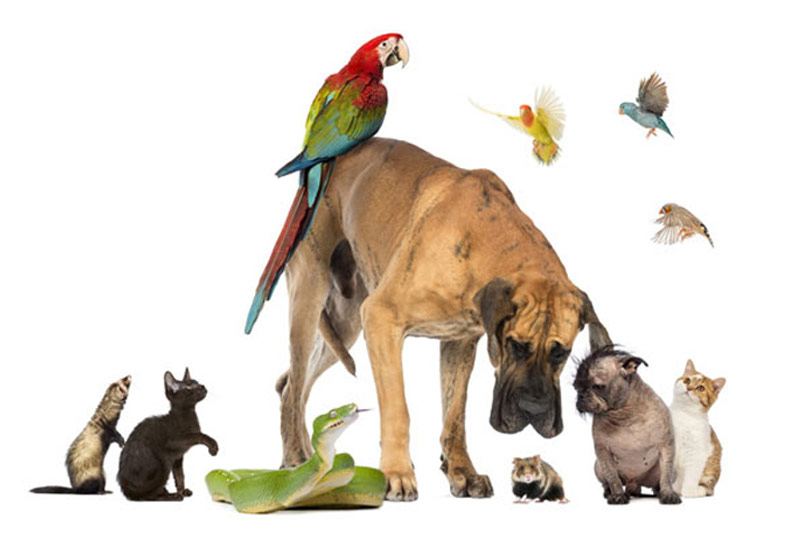Our Research
Read about or listen to our research below, you can also view our latest publications.

Dogs may look adorable when they snooze, but their sleeping habits actually hold fascinating clues on how living with humans has shaped canine behaviour. The sleep-wake patterns of the dog can also serve as a useful model for human sleep and wellbeing research.
Read the full article
Dr Grace Carroll explains the research behind why cats who are left behind when another animal in their home dies could be mourning along with us.
Read the full article
Dr Grace Carroll from the Animal Behaviour Centre describes cat vocal adaptions and why cats meow at humans more than each other.
Read the articleClick on the topic below to view our recent publications.
-
Dogs
Kinnaird, R.F. & Wells, D.L. (2022). The effect of auditory stimulation on pet dogs’ reactions to owner separation. Applied Animal Behaviour Science 254, 105688
Burani, C., Barnard, S., Wells, D.L., Pelosi, A. & Valsecchi, P. (2020). A study on the relation among behavioural profile, problem-solving skills and affective states in shelter dogs raises new issues on judgment bias test. PloS ONE 15, e0241344.
Wells, D.L., Morrison, D. & Hepper, P.G. (2012). The effect of priming on perceptions of dog breed traits. Anthrozoos 25, 369-377.
Wells, D.L. & Hepper, P.G. (2012). The personality of “aggressive” and “non-aggressive” dog owners. Personality and Individual Differences 53, 770-773.
Hepper, P.G. & Wells, D.L. (2005). How many footsteps do dogs need to determine the direction of an odour trail? Chemical Senses 30, 291-298.
Wells, D.L. (2004). A review of environmental enrichment for kennelled dogs, Canis familiaris. Applied Animal Behaviour Science 85, 307-317.
- Cats
Jack, S., & Carroll, G. A. (2022). The effect of baby schema in cats on length of stay in an Irish animal shelter. Animals, 12(11), 1461.
Ellis, S.L.H & Wells, D.L. (2010). The influence of olfactory stimulation on the behaviour of cats housed in a rescue shelter. Applied Animal Behaviour Science, 123, 56-62.
Ellis, S.L.H & Wells, D.L. (2008). The influence of visual stimulation on the behaviour of cats housed in a rescue shelter. Applied Animal Behaviour Science 113, 166-174.
Wells, D.L. & Egli, J.M. (2004). The influence of olfactory enrichment on the behaviour of black-footed cats, Felis nigripes. Applied Animal Behaviour Science 85, 107-119.
Courtney, N. & Wells, D.L. (2002). The discrimination of cat odours by humans. Perception 31, 511-512.
- Primates
Hepper, P.G. & Wells, D.L. (2012). Olfactory discrimination in the western lowland gorillas, Gorilla gorilla gorilla. Primates 53, 121-126.
Hepper, P.G. & Wells, D.L. (2010). Individually identifiable body odors are produced by the gorilla and discriminated by humans. Chemical Senses, 35, 263-268.
Wells, D.L., McDonald, C.L. & Ringland, J.E. (2008). Color preferences in gorillas (Gorilla gorilla gorilla) and chimpanzees (Pan troglodytes). Journal of Comparative Psychology 122, 213-219.
Wells, D.L., Hepper, P.G., Coleman, D. & Challis, M.G. (2007). A note on the effect of olfactory stimulation on the behaviour and welfare of zoo-housed gorillas. Applied Animal Behaviour Science 106, 155-160.
Wells, D.L. (2005). A note on the effect of zoo visitors on the behaviour and welfare of captive gorillas. Applied Animal Behaviour Science 93, 13-17.
- Laterality in Animals
Wells, D.L. (2021). Paw preference as a tool for assessing emotional functioning and welfare in dogs and cats: A review. Applied Animal Behaviour Science 236, 105148.
Wells, D.L. & McDowell, L. (2019). Laterality as a tool for assessing breed differences in emotional reactivity in the domestic cat, Felis silvestris catus. Animals 9, 647.
Wells, D.L., Hepper, P.G., Milligan, A.D.S., & Barnard, S. (2019). Lack of association between paw preference and behaviour problems in the domestic dog, Canis familiaris. Applied Animal Behaviour Science 210, 81-87.
Barnard, S., Wells, D.L., Hepper, P.G. (2018). Laterality as a predictor of coping strategies in dogs entering a rescue shelter. Symmetry 10, 538.
Barnard S., Wells, D.L., Milligan, A.D.S., Arnott, G. & Hepper P.G. (2018). Personality traits affecting judgement bias task performance in dogs (Canis familiaris). Scientific Reports, 8, 6660.
Wells, D.L., Hepper, P.G., Milligan, A.D.S. & Barnard, S. (2018). Stability of motor bias in the domestic dog, Canis familiaris. Behavioural Processes 149, 1-7.
McDowell, L.J., Wells, D.L., Hepper, P.G. (2018). Lateralisation of spontaneous behaviours in the domestic cat, Felis silvestris. Animal Behaviour 135, 37-43.
Wells, D.L., Hepper, P.G., Milligan, A.D.S. & Barnard, S. (2017). Cognitive bias and paw preference in the domestic dog, Canis familiaris. Journal of Comparative Psychology 131, 317-325.
Barnard S., Wells, D.L., Hepper P.G., Milligan A.D.S. (2017). Association between lateral bias and personality traits in the domestic dog. Journal of Comparative Psychology 131, 246-256.
McDowell, L.J., Wells, D.L., Hepper, P.G. & Dempster, M. (2016). Lateral bias and temperament in the domestic cat, Felis silvestris. Journal of Comparative Psychology 130, 313-320.
Wells, D.L., Hepper, P.G., Milligan, A.D.S. & Barnard, S. (2016). Comparing lateral bias in dogs and humans using the KongTM ball test. Applied Animal Behaviour Science 176, 70-76.
Wells, D.L. & Millsopp, S. (2012). The ontogeny of lateralised behaviour in the domestic cat, Felis silvestris catus. Journal of Comparative Psychology 126, 23-30.
Wells, D.L. & Millsopp, S. (2009). Lateralised behaviour in the domestic cat, Felis silvestris catus. Animal Behaviour 78, 537-541.
Wells, D.L., Irwin, R.M. & Hepper, P.G. (2006). Lateralised swimming behaviour in the California sea lion. Behavioural Processes 73, 121-123.
Wells, D.L. (2003). Lateralised behaviour in the domestic dog, Canis familaris. Behavioural Processes 61, 27-35.
- Human-animal relationships
Wells, D.L. & Treacy, K.R. (2024). Pet attachment and owner personality. Frontiers in Psychiatry 15. 1406590.
Carroll, G. A., Reeve, C., & Torjussen, A. (2024). Companion animal adoption and relinquishment during the COVID-19 pandemic: The experiences of animal rescue staff and volunteers. Animal Welfare, 33, e12.
Seery, R & Wells, D. (2024). An exploratory study into the backgrounds and perspectives of equine-assisted service practitioners. Animals 14, 347.
Macri, A.M. & Wells, D.L. (2023). Connecting to zoos and aquariums during a COVID-19 lockdown. Journal of Zoological and Botanical Gardens 4, 476-489.
Carroll, G. A., Torjussen, A., & Reeve, C. (2023). Companion animal adoption and relinquishment during the COVID-19 pandemic: Households with children at greatest risk of relinquishing a cat or dog. Animal Welfare, 32, e56.
Wells, D.L., Clements, M.A., Elliott, L.J., Meehan, E.S., Montgomery, C.J. & Williams, G.A. (2022). Quality of the human-animal bond and mental wellbeing during a COVID-19 lockdown. Anthrozoos.
Carroll, G. A., Torjussen, A., & Reeve, C. (2022). Companion animal adoption and relinquishment during the COVID-19 pandemic: Peri-pandemic pets at greatest risk of relinquishment. Frontiers in Veterinary Science, 9, 1017954.
Carroll, G. A., Groarke, J. M., & Graham-Wisener, L. (2021). Human-centred Research Approaches to Improve Animal Welfare: Survey Design and Stakeholder Involvement. Bridging Research Disciplines to Advance Animal Welfare Science: A Practical Guide, 72-90.
Carroll, G. A., Groarke, J. M., & Graham-Wisener, L. (2021). Human behaviour change models for improving animal welfare. In Bridging research disciplines to advance animal welfare science: A practical guide (pp. 91-106). GB: CABI.
Carroll, G. A., Cohen, L. R., McParland, A., Jack, S., & Montrose, V. T. (2020). Individuals with psychopathic traits and poor attitudes towards animals can recognise infant features but give them reduced attentional priority. Animals, 10(4), 721.
Wells, D.L. (2019). The state of research on human-animal relations. Anthrozoos 32, 169-181.
Carroll, G. A., & Groarke, J. M. (2019). The importance of the social sciences in reducing tail biting prevalence in pigs. Animals, 9(9), 591.
Levine, G., Allen, K., Braun, L.T., Christian, H.E., Friedmann, E., Taubert, K.A., Thomas, S.A., Wells, D.L. & Lange, R.A. (2013). Pet ownership and cardiovascular risk: a scientific statement from the American Heart Association. Circulation 127, 2353-2363.
Wells, D.L. (2012). Dogs as a diagnostic tool for ill-health in humans. Alternative Therapies in Health and Medicine 18, 12-17.
Wells, D.L. (2011). The value of pets for human health. The Psychologist 24, 172-176.
Wells, D.L., Lawson, S.W. & Siriwardena, N. (2011). Feline responses to hypoglycaemia in patients with Type 1 diabetes. Journal of Alternative and Complementary Medicine 17, 99-100.
Wells, D.L. (2009). The effect of animals on human health and well-being. Journal of Social Issues 65, 523-543.
Wells, D.L. (2009). Associations between pet ownership and self-reported health status in people suffering from chronic fatigue syndrome. Journal of Alternative and Complementary Medicine 15, 407-413.
Wells, D.L., Lawson, S.W. & Siriwardena, N. (2008). Canine responses to hypoglycaemia in patients with Type 1 diabetes. Journal of Alternative and Complementary Medicine 14, 1235-1241.
Wells, D.L. (2007). Domestic dogs and human health: an overview. British Journal of Health Psychology 12, 145-156.

